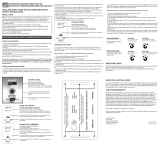
20
I-EEDU (02-21) 150492-A
INSTALLATION—CONTINUED
Piping Connections—Continued
High Elevation (>2,000 Feet/609 Meters) Installations—Continued
⚠ DANGER ⚠
• Do not use Teflon tape or pipe joint compound on the orifice threads. The hole in the orifice may
become blocked and may cause fire, explosion, property damage, carbon monoxide poisoning,
personal injury, or death.
• Use only using factory-supplied orifices. Do not attempt to drill out orifices in the field. Improperly
drilled orifices may cause fire, explosion, carbon monoxide poisoning, personal injury, or death.
4. Thread replacement gas orifices into gas manifold. To prevent cross-threading, hand-tighten orifices into gas
manifold until snug and then tighten one-half to one turn using wrench.
⚠ DANGER ⚠
DO NOT use an open flame to check for gas leaks.
Table 13. High Elevation Burner Orifices
Installation
Altitude (Feet)
Installation
Location
Unit Size
Natural Gas Propane
PN Orifice Size PN Orifice Size
2001–3000 US
075 16590 #46 39658 #56
100, 125 84437 #42 11834 #54
140, 170, 200, 225 45871 #39 9789 #53
250 87391 #40 9789 #53
300, 350, 400 87391 #40 11834 #54
2001–4500 Canada
075 84853 #47 63922 1.15 mm
100, 125 84437 #42 11834 #54
140, 170, 200, 225, 250 11792 #41 61652 1.45 mm
300, 350, 400 11792 #41 11834 #54
3001–4000 US
075 84853 #47 63922 1.15 mm
100, 125 84437 #42 11834 #54
140, 170, 200, 225 87391 #40 9789 #53
250 11792 #41 9789 #53
300, 350, 400 11792 #41 11834 #54
4001–5000 US
075 84853 #47 63922 1.15 mm
100, 125 84437 #42 11834 #54
140, 170, 200, 225, 250 11792 #41 61652 1.45 mm
300, 350, 400 11792 #41 11834 #54
5001–6000 US
075 84853 #47 63922 1.15 mm
100, 125 11828 #43 97360 1.35 mm
140, 170, 200, 225 11792 #41 61652 1.45 mm
250 84437 #42 61652 1.45 mm
300, 350, 400 84437 #42 11834 #54
6001–7000 US
075 40414 #48 40416 #57
100, 125 11828 #43 97360 1.35 mm
140, 170, 200, 225, 250 84437 #42 61652 1.45 mm
300, 350, 400 84437 #42 11834 #54
7001–8000 US
075 40414 #48 40416 #57
100, 125 11833 #44 11830 #55
140, 170, 200, 225 84437 #42 11834 #54
250, 300, 350, 400 11828 #43 11834 #54
8001–9000 US
075 39651 #49 40416 #57
100, 125 11833 #44 11830 #55
140, 170, 200, 225, 250 11828 #43 11834 #54
300, 350, 400 11828 #43 11830 #55




















